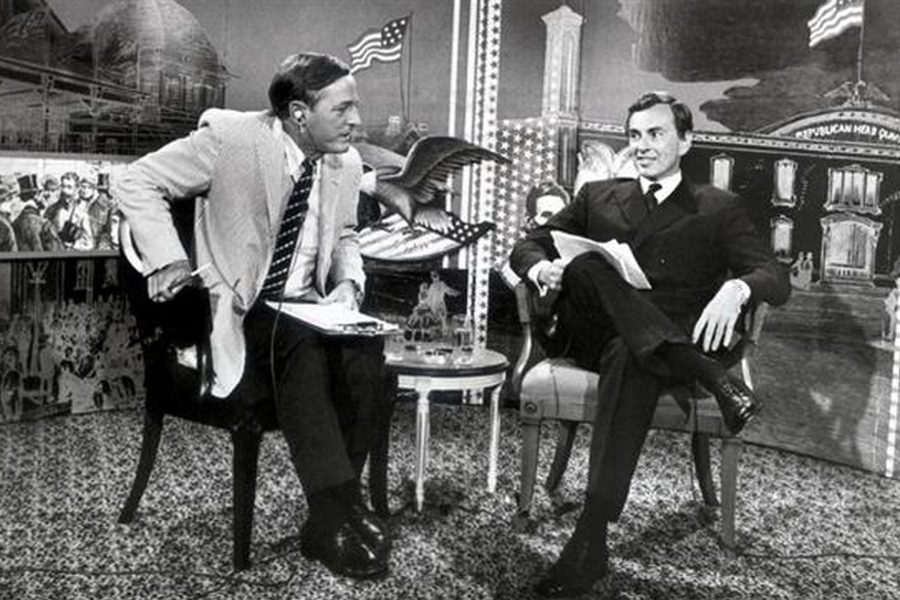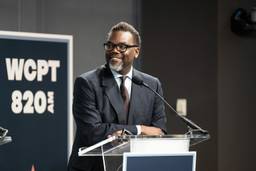‘Best of Enemies’ Provides a View of Gore Vidal, William F. Buckley and the 1960s From the Bathroom
The new documentary contains lots of shouting but only passing hints at substance.
Kevin Schultz

As Morgan Neville and Robert Gordon’s new film Best of Enemies opens, we get a beautiful, prolonged glimpse of the placid seas of the Italian coastline, upon which sits the sumptuous villa of the elegant left-wing novelist and general gadfly of traditional America, Gore Vidal. Waves crash, seas churn and we’re put in a tranquil mood. Then we cut to Vidal himself, who is giving a tour of the villa’s bathroom.
In the place of honor, centrally located above the bathtub, sits a series of photographs of William F. Buckley, Jr., the right-wing firebrand of the 1950s, ‘60s, and ‘70s, debating Vidal in 1968. Buckley looks angry and mean, and to almost every American in the 1960s and ‘70s, the photographs would recall the time Buckley called Vidal a “queer” on national television, before threatening to punch him in the face. Underneath the Right’s seemingly respectable political positions, Vidal seems to be implying, is anger and hatred and even the threat of violence.
As metaphors go, this one’s not too subtle: it was Gore Vidal and William Buckley’s series of 10 debates during the 1968 political conventions, the filmmakers posit, that took American political debate from relative tranquility to distasteful contentiousness. It’s a contention we want to believe so badly. We want to be able to point to a precise moment in time when American intellectual life went from respectful and potentially enriching to the crass, bloviating, screaming discourse we live with today that the story almost just works.
Best of Enemies does what documentaries do best: It vividly evokes a different time and place, when the set of assumptions guiding life were different from our own. Taking us back to the middle 1960s, there are grainy out takes of old television shows and glimpses of news anchors fixing their hair after they thought the rolling had stopped. Wry smiles appear after pointed barbs. The film’s central premise is that when ABC Television brought together Buckley and Vidal to debate the 1968 Republican and Democratic conventions, the two men’s pointed hatred for one another, coming to its most vicious culmination when the battles of Chicago raged outside, “changed television forever,” as one of the commentators puts it rather grandly.
Before the Buckley-Vidal debates of 1968, so the narrative implies, we had hours of unbroken convention coverage with anchors as dull and monotonous as the black-and-white images they projected; after Buckley-Vidal, we have a new beast, with networks concocting angry fights in order to draw in the viewers. “They’re the sugar and we’re just flies,” says one aging television executive interviewed by Neville and Gordon, before the executive looks away with a mixture of anger and sadness.
The premise of the film may or may not be true, and it’s a bit frustrating that the filmmakers mostly make their case while the credits are rolling. There certainly was spirited debate on television before 1968. One thinks of Dick Cavett, or Mike Wallace, or David Susskind’s shows as prime examples. And there was even William F. Buckley’s own “Firing Line,” which premiered in 1966 and made itself famous by mocking and challenging its left-wing guests.
So did “television change forever” in 1968? It’s hard to say. Although ABC did get a bump in the ratings during the 1968 convention, it’s hardly clear that this was a result of the Buckley-Vidal debates. ABC had streamlined its coverage and opted to show highlights rather than the convention’s entirety, and that very well may have made the difference.
At any rate, the highlight of both the debate and the film came during the ninth of the 10 debates, while the worst of the violence was raging throughout Richard Daley’s Chicago, blue-helmeted cops beating the antiwar protestors while “the whole world was watching.” Tear gas had drifted into the hotel the night before, and Buckley didn’t sleep well. He was highly irritable anyway. Vidal had decided from the beginning that this wouldn’t be about ideology but about destroying the person of William F. Buckley, trying to make Buckley’s anger eek out in order to be able to argue that conservatives are little more than greedy unprincipled bullies.
In their first meeting, Vidal — who was bisexual himself, though he shunned any labels for his or anyone else’s sexual behavior — implied Buckley was a homosexual. He perpetually refused to say the name of Buckley’s influential magazine, National Review, and eventually he called Buckley a “crypto-Nazi.” At that moment, we watch Buckley lose his cool, something snaps inside, and Buckley utters the memorable words: “Now listen, you queer, stop calling me a crypto-Nazi or I’ll sock you in the goddam face….”
“Oh, Bill,” Vidal interrupted, loving every minute of it, “you’re so extraordinary….”
Buckley talked over him: “…and you’ll stay plastered.”
We get to see the sequence no less than four times — sometimes even in slow motion.
Buckley instantly knew he had lost the debate, and for the rest of his life, he rued that moment. He had lost his cool, uttered words he shouldn’t have, and seemingly done deep damage to the conservative movement he had been working his whole life to build. In the green room afterward, Vidal said to Buckley, “Well, I guess we gave them their money’s worth.” Buckley refused to acknowledge Vidal, took out his earpiece, and walked away, more mad at himself than at Vidal.
Vidal was right in one respect: ABC did get its money’s worth. When it conjured up the idea for the debate, the network knew it would have to get Buckley, the photogenic star of the Right, so they asked him first. When Buckley agreed, ABC asked him whom he’d like to debate. He gave a list of serious thinkers: John Kenneth Galbraith, Norman Mailer, others. Was there anyone he wouldn’t debate? Here, he only put down one name: Gore Vidal. Guess whom they picked?
Sidestepping the debatable argument that the Buckley-Vidal debate “changed television forever,” the other flaw in the film is the allergic reaction it has toward ideas. We never learn what policies and politics either man supported. We never get a glimpse into the kinds of people who supported them. We never see how the political turmoil convulsing all over Chicago in 1968 affected either man or the movements they sought to represent.
Instead, we delve into the psychological. Buckley and Vidal, the filmmakers suggest, hated each other not because of politics but because of culture. They viewed each other not as advocates of differing visions of America but instead as sort of playhouse mirror images of themselves. Vidal the great provocateur could recognize in Buckley a handful of his own family members and the worst of the rah-rah boosterism of “my country, right or wrong.” Buckley could see in Vidal the gay, overly sexualized black sheep that his family very well might have produced and tried to hide. Thus the two men saw in one another the anxieties the other person so clearly wanted to kill within themselves and within the nation. They were a threat, one they could understand all too well and thus one that had to be annihilated.
Perhaps this is a revealing way to understand the 1960s, but it elides ideas almost entirely. What about Vietnam? What about Richard Nixon? What about Lyndon Johnson, Hubert Humphrey, the assassinations of Martin Luther King, Jr., and Robert Kennedy, the storming of the universities, the rise of Black Power, Brown Power, Red Power, feminism? Was there something aside from personal distaste that affected these men and their nation?
Unfortunately, the big guns brought in to shape the movie’s narrative, including admirable performances by Christopher Hitchens, Sam Tanenhaus and Brooke Gladstone, and featuring the somewhat curious decision to have Kelsey Grammer and John Lithgow serve as the voices of Buckley and Vidal, respectively, all focus their efforts on that single moment when Vidal called Buckley a Nazi and Buckley called Vidal a queer.
Ugly stuff, all of it, and that, of course, is the point. But there is one fleeting moment where politics take center stage. At one point during the debate, Vidal tries to demonstrate how flawed the United States is by pointing out that, in 1968, the richest five percent of Americans possessed roughly twenty percent of the nation’s wealth, while the poorest twenty percent owned just five percent. Today, when those numbers have grown exponentially worse, one can’t help but to wonder what all the shouting was about.




